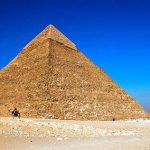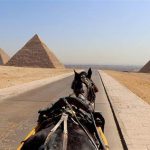Symbols of Osiris
We’ll know everything about Symbols of Osiris in detail through this digital report from the FTS blog.
The Ancient Egyptians were recognized to be a deeply religious people. They presumed that everyone in life happened due to various gods, each with their realm. Numerous gods were recognized to rule over numerous things in the world and life.
Osiris is frequently portrayed as a green-skinned god. This is symbolic of the god’s conceptual essence. It symbolizes reincarnation, procreation, and greenery.
Symbols of Osiris
Osiris was born to the founder gods Geb and Nut. He was Egypt’s 1st king and the Lord of the Earth. Osiris ruled alongside Isis, his queen, and collaborator.
Historians think Osiris existed before divinity, as either the ruler of the Netherworld or as a god of reproduction and expansion. Such or before tales and retellings were combined into single cohesive writing known as the Osiris myth. Some observers believe that the myth reflects a regional war in Egypt.
Whenever the Greeks colonized Egypt, the myth of Osiris took on a completely new shape. The Greeks adjusted the myth in their sense.
Crook and Flail
The crook was known as a heka, derived from the employee’s shepherds used to safeguard their flocks. It was recognized as a sign for the pharaoh because they shielded and cared for the Egyptian people.
The flail is a nekhakha, a rod with three beads at the top. Scholars have had some hypotheses about how it was used. However, there are mainly two explanations of how the flail came to be.
According to one analysis, it was frequently used to thresh wheat in the disciplines. It is supposed to indicate the pharaoh’s interest in safeguarding the territory so that there would be cuisine for the humans to consume and supply for them.
The second example was that it was used as a gun to protect the sheep herd, which has been construed as the role of the pharaoh in maintaining order and culture.
Atef Crown
The Hedjet is featured on the Atef crown, with only an ostrich feather along either side.
The Atef Crown was worn all through religious ceremonies. On the white crown’s pinnacle, it has a gold disc and ostrich feathers. It must have been worn by Osiris, Egypt’s first ruler, once he governed as the god of agricultural production and vegetation.
Once Osiris overcame death after Isis breathed life into him, the pharaohs believed that they, too, would’ve been transformed into Osiris after death. All Egyptian devotees and kingdoms revered Osiris as the final King, representing the ever-changing life cycle, fatality, and rebirth.
Djed
The djed is a vital sign of power and consistency. It is also supposed to indicate his spine.
The Djed is a pillar that reflects Osiris’ spine, or intestinal fortitude. It also represented all the killed affiliated with him there, the leader of the Netherworld.
Mummy Gauze
Because Osiris was the first king, he was also linked with the notion of mummy gauze wrap. Isis reassembled and formed a bond with him after he was decided to kill and broken into slices by Seth. It’s what brought him back to living. His gauze stayed the leader of the Netherworld as well.
Green Skin
Green was, slightly expectedly, associated with greenery and existence in Egypt. Even so, it was affiliated with ideas of death. Osiris was indeed the god of reproduction, the hereafter, and death, and he has been frequently depicted with green skin.
Because of the beetle’s representational notion of rebirth and eternal life, famous amulets, onagers, and seals were commonly green.
Green pigments deduced from the mineral semiprecious stones were the oldest and most prevalent. It is vulnerable to high heat and acid exposure; this is why it is recognized as a steady colorant and prevalent copper carbonate – recognized to be sturdy.
It was broadly used by Egyptian tomb painters as early as the fourth Dynasty, but it wasn’t broadly used during European art until the 16th century.
Black Skin
Osiris has sometimes been represented with black skin, which also symbolized the sperm quality of the Nile River valley.
The Egyptians affiliated black with dying as well as the underworld. Because he is the afterlife’s King or queen, he and the god of mummification, Anubis, are depicted with black faces. Osiris was also known as “the black one.”
Because much of their agriculture was predicated on the rich black silt generated on the Nile’s financial institutions during the deluge, the Egyptians associated black with reincarnation and procreation.
Whenever it came to trying to represent awakening, both green, as well as black were equal. As a result, the god Osiris was portrayed as having dark or green skin to emphasize his sperm quality.
Isis, Osiris’ sister, and Osiris
Osiris was Egypt’s first supreme ruler and successfully implemented human civilization and agricultural production in the regions. After completing his basic responsibilities, Osiris embarked on a worldwide tour with his sister and consort, Isis.
When the brother and sister returned to their empire after a few months, they were met with a fierce challenging task. Set, Osiris’ brother, was preparing to usurp the throne, but their return thwarted his proposals. Predefined slew and maimed Osiris to prevent him from climbing up to the throne.
Following this heinous event, Isis and Horus resolved to take revenge on the dead King. Set was defeated by Isis as well as her son. Isis then gathered all of Osiris’ body parts and buried him.
Osiris and His Relationship with Nephthys
Osiris, the Egyptian King, was an impressive leader as well King. Set, his brother, was always envious of his brother’s unique abilities. Once Set’s courtier, Nephthys, fell madly in love with Osiris, he became more jealous. Set, enraged, also couldn’t control his anger and frustration and assassinated Osiris by trying to attack him as a monster. According to some accounts, he was killed by trying to drown in the Nile River.
On the other hand, Set did not stop at murder; he disemboweled Osiris’ body to ensure the King’s demise. He then dismembered the god’s body and dispersed it throughout the country.
The Myth of Osiris’ Representational Definitions
The legend of Osiris represents the conflict between order and disease. The myth depicts Ma’at or the natural laws of the world. Infractions, like Set trying to usurp the throne and murdering Osiris, continuously disrupt this balancing act. On the other hand, the legend presents the message that evil could never preside for long and that Maat would ultimately be regained.
The Osiris myth also represented the continuous cycle of birth, death, and the hereafter. As the god of the afterworld, Osiris has come to mean rebirth and reincarnation. As a result, numerous Egyptian kings recognized the Osiris myth to guarantee a second coming via their decedents.
The myth of Osiris was also a crucial source of hope and procreation for the Egyptians. The Nile River’s flash floods were affiliated with Osiris’ bodily secretions. The flood was considered a boon from Osiris, allowing for a bountiful expansion of plants and animals.
Festivals Held in Memory of Osiris
A few Egyptian festivals, including The Fall of the Nile and the Djed Pillar Festival, commemorated Osiris’ return and reincarnation. The plantation of seeds and crops was one of the most rites in these cultural events. Men and women will dig up many bedrooms of soil and crop seeds in them; The expansion and growing conditions of these seedlings represented Osiris’ return.
Long television shows based on the myth of Osiris were implemented and conducted at these festivals. These plotlines would be certain of the King’s rebirth and reincarnation. A few folks would also create a model of Osiris out of monastery wheat and water to represent his resurrection from the dead.
Osiris mythological texts from antiquity
During the Old Kingdom, the myth of Osiris first seems in the Pyramid Texts. The full account of the legend, notwithstanding, did not appear until many years later, in the Awesome Hymn to Osiris. The legend was also humorously reimagined in The Contending’s of Horus and Set, authored during the 20th Dynasty.
Nevertheless, this was the Ancient Greek and Roman writers who gathered the false narrative into a cohesive whole and devised a detailed record of the specifics. As a result, much of what we currently know stems from demonstrating the potential of ancient Greek and Roman authors.
Osiris Myth in Popular Culture
Osiris seems like a god of death and the hereafter in successful movies, video games, and tv programs. In the film Gods of Egypt, Osiris seems like a ruler of Egypt and therefore is assassinated by his brother Set. Horus, his son, persists in his lineage.
Osiris also appears in the tv show Paranormal. In the seventh season, he arises as to the god of death, judging Dean’s virtues and flaws.
In Summary
Because of its approachable story, theme, and plot, the legend of Osiris remains among the most famous and respected Egyptian mythologies. It has sparked authors’ imaginations, creative types, and even new religious movements.
We knew everything about Symbols of Osiris in detail through the previous points, and we hope you like it too much.








